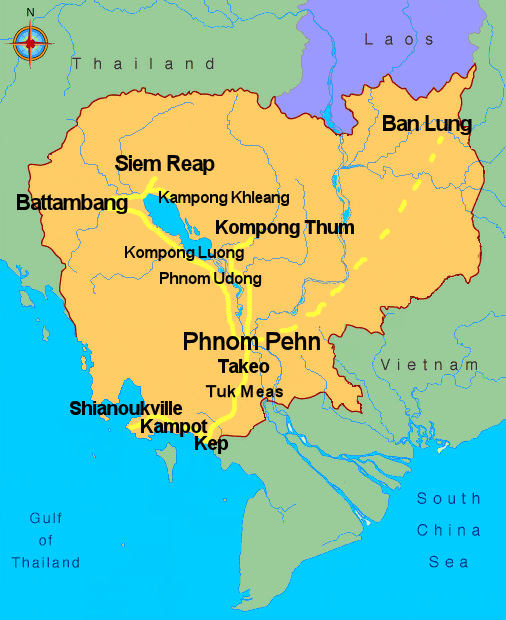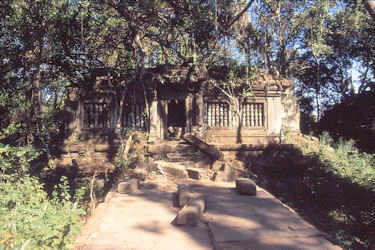Cambodia

Historie
Radiocarbon dating of a cave at Laang Spean in Battambang Province, northwest Cambodia confirmed the presence of Hoabinhian
stone tools from 6000–7000 BC and pottery from 4200 BC. Finds since 2012 lead to the common interpretation, that the cave contains
the archaeological remains of a first occupation by hunter and gatherer groups, followed by Neolithic people with highly developed
hunting strategies and stone tool making techniques, as well as highly artistic pottery making and design, and with elaborate social,
cultural, symbolic and exequial practices.
Skulls and human bones found at Samrong Sen in Kampong Chhnang Province date from 1500 BC.
Chinese annals contain detailed records of the first known organised polity, the Kingdom of Funan. Centered around the lower
Mekong and Bassac rivers from the first to sixth century AD with "walled and moated cities" such as Angkor Borei in
Takeo Province and Óc Eo in modern An Giang Province, Vietnam.
Early Funan was composed of loose communities, each with its own ruler, linked by a common culture and a shared economy of rice farming
people in the hinterland and traders in the coastal towns, who were economically interdependent, as surplus rice production found its way
to the ports.
Originally one of the regional centers of Funan with an unknown degree of sovereignty, Chenla was recognized by a foreign power as
a separate political entity at the end of the sixth century, with Bhavavarman I (550-590) as its independent ruler.
The History of the T'ang asserts that shortly after 706 the country was split into Land Chenla and Water Chenla. The
names signify a northern and a southern half, which may conveniently be referred to as Upper and Lower Chenla.
By the late 8th century Water Chenla was absorbed by the Malays of the Srivijaya Empire and the Javanese of the Shailandra
Empire and eventually incorporated into Java and Srivijaya.
Jayavarman II, ruler of Land Chenla, initiates a mythical Hindu consecration ceremony at Mount Kulen (Mount Mahendra) in
802 AD, intended to proclaim political autonomy and royal legitimacy. As he declared himself "devaraja" - god-king, divinely
appointed and uncontested, he simultaneously declares independence from Shailandra and Srivijaya.
He established Hariharalaya, the first capital of the Angkorean area near the modern town of Roluos.
Indravarman I (877–889) and his son and successor Yasovarman I (889–900), who established the capital Yasodharapura
ordered the construction of huge water reservoirs (barays) north of the capital. The water management network depended on elaborate
configurations of channels, ponds, and embankments built from huge quantities of clayey sand, the available bulk material on the Angkor
plain.
The area that comprises the various capitals was spread out over around 1,000 km2, it is nowadays commonly called Angkor. The
combination of sophisticated wet-rice agriculture, based on an engineered irrigation system and the Tonlé Sap's spectacular
abundance in fish and aquatic fauna, as protein source guaranteed a regular food surplus.
Under king Suryavarman II (1113–1150) the empire reached its greatest geographic extent as it directly or indirectly controlled
Indochina, the Gulf of Thailand and large areas of northern maritime Southeast Asia. Suryavarman II commissioned the temple of Angkor
Wat, built in a period of 37 years, its five towers representing Mount Meru is considered to be the most accomplished expression
of classical Khmer architecture.
King Jayavarman VII (reigned 1181–1219) is generally considered to be Cambodia's greatest King. A Mahayana Buddhist, he initiates
his reign by striking back against Champa in a successful campaign. During his nearly forty years in power he becomes the most
prolific monument builder, who establishes the city of Angkor Thom with its central temple the Bayon.
A conclusive explanation that relates to concrete events manifesting the decline of the Khmer Empire has not yet been produced.
However, most modern historians consent that several distinct and gradual changes of religious, dynastic, administrative and military
nature, environmental problems and ecological imbalance coincided with shifts of power in Indochina and must all be taken into account
to make an interpretation.
The central reference point for the entire 15th century is a Siamese intervention of some undisclosed nature at the capital Yasodharapura
(Angkor Thom) around the year 1431. Historians relate the event to the shift of Cambodia's political centre southward to the region of
Phnom Penh, Longvek and later Oudong.
Siamese and Vietnamese dominance intensified during the 17th and 18th century, resulting in frequent displacements of the seat of power as
the Khmer royal authority decreased to the state of a vassal.
In the early 19th century with dynasties in Vietnam and Siam firmly established, Cambodia was placed under joint suzerainty, having lost
its national sovereignty. To save Cambodia from being incorporated into Vietnam and Siam, King Ang Duong agreed to colonial
France's offers of protection, which took effect with King Norodom Prohmbarirak signing and officially recognising the French
protectorate on 11 August 1863.
Norodom died in 1904, and his two successors, Sisowath and Monivong, were content to allow the French to control the
country. King Monivong died in April 1941 and the French placed the obscure Prince Norodom Sihanouk on the throne as king, believing
that the inexperienced 18-year old would be more pliable than Monivong's middle-aged son, Prince Monireth.
Cambodia gained independence from France on 9 November 1953.
The Cambodian Civil War (1967 - 1975) was fought between the forces of the Communist Party of Kampuchea (known as the
"Khmer Rouge", supported by North Vietnam and the Viet Cong) against the government forces of the Kingdom of Cambodia and,
after October 1970, the Khmer Republic, which had succeeded the kingdom (both supported by the United States (U.S.) and South
Vietnam).
The Khmer Rouge reached Phnom Penh and took power on 17 April 1975. Led by Pol Pot, they changed the official name of the
country to Democratic Kampuchea.
The new regime modelled itself on Maoist China during the "Great Leap Forward", immediately evacuated the cities, and sent the entire
population on forced marches to rural work projects. They attempted to rebuild the country's agriculture on the model of the 11th century,
discarded Western medicine and destroyed temples, libraries, and anything considered Western.
Estimates as to how many people were killed by the Khmer Rouge regime range from approximately one to three million; the most commonly
cited figure is two million (about a quarter of the population). This era gave rise to the term Killing Fields, and the prison
Tuol Sleng became notorious for its history of mass killing.
On 10 January 1979, after the Vietnamese army and the KUFNS (Kampuchean United Front for National Salvation) invaded Cambodia and
overthrowing the Khmer Rouge, the new People's Republic of Kampuchea (PRK) was established with
Heng Samrin as head of state. Pol Pot's Khmer Rouge forces retreated rapidly to the jungles near the Thai border.
The Khmer Rouge and the PRK began a costly struggle that played into the hands of the larger powers China, the United States and the
Soviet Union.
Peace efforts began in Paris in 1989 under the State of Cambodia, culminating two years later in October 1991 in a comprehensive peace
settlement. The United Nations was given a mandate to enforce a ceasefire and deal with refugees and disarmament known as the United
Nations Transitional Authority in Cambodia (UNTAC).
In 1993, Norodom Sihanouk was restored as King of Cambodia, but all power was in the hands of the government established after
the UNTAC sponsored elections.
The stability established following the conflict was shaken in 1997 by a coup d'état led by the co-Prime Minister
Hun Sen against the non-communist parties in the government.
Although Sen's rule has been marred by human rights abuses and corruption, most Cambodian citizens through the 2000s maintained approval
of the government; interviews with rural Cambodians in 2008 displayed a preference for a stable status quo over potentially violent change.
My first visit to Cambodia was in august 2002
These are the places I have seen on that trip
Phnom Phen
Takeo
Tuk Meas
Kep
Kampot
Sihanoukville
Ban Lung
Kompong Thom
Phnom Udong
Kompong Luong
Battambang
Siem Reap
My second visit to Cambodia was in december 2007
These are the places i have seen on that trip
Siem Reap
Kampong Khleang
Phnom Penh
Please let me know when you're having questions.
i would be pleased to help you.
Things to do and other tips

This illustrate's my memories of Cambodia:
The remote temple of Beng Mealea
See my "Things to do" pages for more pictures.
These are divided in:
"Cambodia"
"Temples of Angkor"
"Cambodia Revisited"
When i'am visiting a country i like to be prepared;
So i know something about the Country and i can plan the things to visit.
That's why i 'm reading books;looking at travel maps etc.
See my "Things to read" pages for Books/Maps about
Cambodia
"Temples of Angkor"
"Cambodia Revisited"